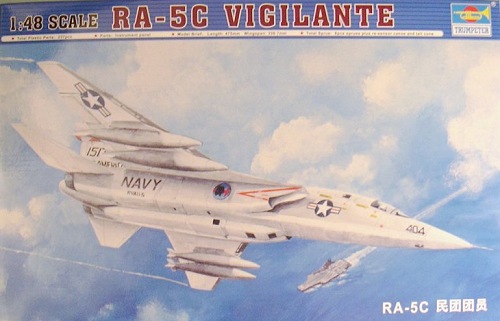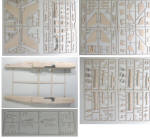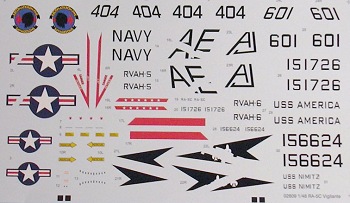
| KIT: | Trumpeter 1/48 RA-5C Vigilante |
| KIT #: | 02809 |
| PRICE: | $74.95 MSRP |
| DECALS: | Two options |
| REVIEWER: | Tom Cleaver |
| NOTES: |

| HISTORY |
Known as “the Cadillac of carrier-based aircraft” to those who flew it, the North American Vigilante began life in the mid-1950s in response to a BuAer RFP for a supersonic, carrier-based strategic bomber in the nuclear strike role.
Eventually given the name “Vigilante,” the A3J-1 was a Mach 2 all-weather carrier-based attack bomber. Fitted with the new low-altitude bombing system (LABS) and an inertial navigation system (INS), the A3J-1 could carry a 3,020 lb Mk-27 nuclear store or a 1,885 lb Mk-28 weapon. The “Vigilante" was the first production aircraft to use variable geometry intakes and to sacrifice conventional control surfaces, using spoilers for roll control and all-slab tail surfaces with differential movement for maneuverability. The prototype XA3J-1 was first flown in August 1958. A production A3J-1 later established a new world altitude record of 91,450 feet in December 1963, carrying a 1,000 kg payload and surpassing the existing record by over 27,000 feet.
By the time the A3J-1 entered service in 1962, the Navy’s strategic strike force was the new Polaris submarine fleet, and the airplane had no role. After some 40 were completed, the RA-5C - a dedicated reconnaissance version - first appeared as a prototype in 1962, and entered operational service in 1964. Yours truly saw one of the first of these monsters take off from NAS North Island and circle San Diego harbor, its J-79s screaming as it made a very impressive sight with its great size.
The A3J-1s, redesignated A-5A, were later returned to the North American factory in Columbus, Ohio, where they were remanufactured as RA-5Cs to join 46 new-build RA-5Cs with production completed by late 1965. Due to the high loss rate over North Vietnam, the Vigilante production line was re-established in 1967 and 36 new “136 series” RA-5Cs were produced between 1968-70, distinguishable from the earlier versions by a leading edge extension from just outboard the fuselage to the front tip of the intake, which provided superior low speed control response.
RA-5Cs first entered operations over South Vietnam in 1964. By 1965, they began operating over North Vietnam. The RA-5C had the highest loss rate of any Navy aircraft used during the war, with two lost to SAMs and 11 to AAA. This was due to the airplane’s mission: the RA-5C would precede an Alpha Strike into the target for pre-strike photos, which was relatively safe. However, the airplane then had to return some ten minutes after the strike - to allow the smoke and dust to settle - flying alone without flak suppression, and the gunners knew exactly where it was headed.
The Vigilante could outfly any other Navy aircraft in terms of flat-out speed. North American engineers always claimed that pegging the maximum speed at Mach 2 was a conservative Navy decision. In 1969, they took a new “136 series” Vigilante off the production line, removed the recon “canoe,” and prepared the airplane to participate in the Royal Mail Atlantic Race in the unlimited category. In test flights, the airplane achieved Mach 2.5 and the pilot reported he felt it could go faster. KA-3B tankers were spotted across the Atlantic for the flight, and it was expected the Vigilante would perhaps hit Mach 2.7. The Navy stopped the project, and the race was ultimately won by an RAF Phantom that would surely have had its tail feathers waxed if the Vigilante had only flown at maximum military-approved speed.
The Vigilante remained in service until 1979 when it was finally retired. It was the biggest, fastest airplane to ever regularly operate from a carrier deck.
| THE KIT |
 The parts are typical Trumpeter: cleanly molded, with lots of potential
detailing possibilities. 237 parts on eight sprues. My one complaint is my
usual complaint: stop it already with the fershlugginah engraved
rivets!!!! Please?
The parts are typical Trumpeter: cleanly molded, with lots of potential
detailing possibilities. 237 parts on eight sprues. My one complaint is my
usual complaint: stop it already with the fershlugginah engraved
rivets!!!! Please?
The kit provides decals for two aircraft - BuNo 151726 from RVAH-5 aboard
USS “America,” and BuNo156624 from RVAH-6 aboard USS Nimitz in the 1970s.
Given that the kit is a “136 series” late production airplane, it strikes
me that the RVAH-5 airplane is incorrect by its BuNo unless the modeler is prepared to modify the model to an early-production RA-5C (or modify the BuNo to a late-production number). One hopes the decal aftermarket
companies will do the other units who used this airplane, since in my
opinion there are some better-looking unit markings.
prepared to modify the model to an early-production RA-5C (or modify the BuNo to a late-production number). One hopes the decal aftermarket
companies will do the other units who used this airplane, since in my
opinion there are some better-looking unit markings.
Fotios Rouch - a very knowledgeable source on the Vigilante - has informed me that there are some minor points on the kit that are items associated with the early-production airplane, though the airframe is primarily a late-production airplane. Fotios says that none of the discrepancies are so major as to require their public detailing, and believes the kit will make up into a good-looking Vigilante.
Warning - Editorial rant ahead:
There has been a loud wail for many years from modelers yearning for a kit of this airplane in 1/48. Naturally, immediately upon someone laying hands on a test shot, the lamentations from ScuttlebuttCentral crescendoed, leaving the average modeler who might like to buy the kit thinking it was another Trumpeter disaster. I am reliably informed by someone in a position to know what they are talking about that distributors’ orders for the kit were cut back in the face of this 10-person “chorus” (are ten sopranos a chorus?). This is sad, and it makes me angry, because the truth is this is a good kit and fully worthy of you spending your hard-earned dollars, euros, zlotys or whatever to obtain it. Those of you who know my reputation know I have had no problem calling Trumpeter out for their transgressions, but this ain’t one of them.
In light of all the PMS, when my kit arrived I pulled it out of the very strong box, opened the bags, took the parts that were subject of the highest degree of PMSing and gave them a good “eyeballing” with the photos of the 1:1 airplane at Pima Air Museum taken by Fotios Rouch. If there were problems with these parts before, they have obviously been fixed. Particularly, the pilot’s canopy matches the photos in cross section as closely as anyone could hope for in a plastic kit.
Given that the alternative is the Collectaire kit, for which one hears nothing but horror stories from those who have attempted to build one, I for one hope this kit does not suffer the fate of the PBY Catalina and Ju-52/3m that Monogram released in response to the cries of all the modelers over the years who kept putting the two models atop their “most wanted kit” lists and then let them shelf-sit in droves when presented with two excellent juts that make up into damn good models (and I have done more than one of both, so I know what I’m talking about). If you people keep this up, you’d best stop complaining when you’re treated like the little boy who cried wolf. Yes. Complain about the 1/24 P-51D and Zero, and bravo for getting them to re-do the F4F-4. But remember to insure your brain’s running on fresh air and you haven’t had your head where you’ve been breathing stuff from you-know-where before you “demonstrate your expertise.”
| CONCLUSIONS |
In conclusion, let me say that a long long time ago, the Chief Petty Officer who was my Navy recruit company commander once told us that the best solution for scuttlebutt was to “believe nothing that you hear and only half of what you see.” I suggest you follow that admonition when listening to the “drips-under-pressure” (my father’s term for an “expert” - and he knew what he was talking about) over at ScuttlebuttCentral. Otherwise, you’re going to miss out on one of Trumpeter’s nicest kits to date, the only model you’re likely ever to see of this interesting airplane in this scale that is as well-designed and accurate as this one is. For what’s in the box, it’s a bargain. Buy in confidence.
Review Kit courtesy of Stevens International.
February 2005
If you would like your product reviewed fairly and quickly by a site that has 300,000 visitors a month, please contact me or see other details in the Note to Contributors.